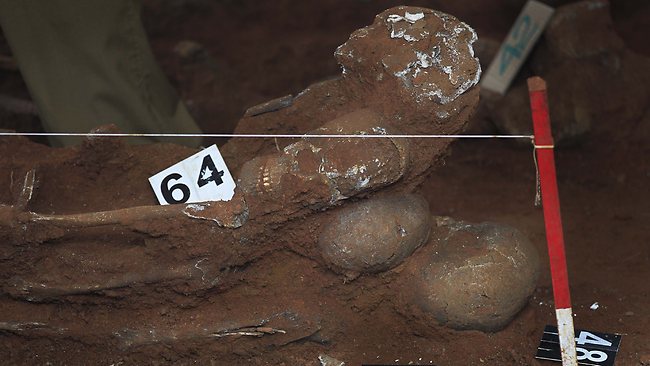![620042-sri-lanka-skeletons[1]](https://srilankabrief.org/wp-content/uploads/2014/01/620042-sri-lanka-skeletons1-300x168.jpg) |
|
inShare
A group of construction workers who were laying water pipes stumbled across and unmarked mass grave in the North-Western town of Mannar. This is what has happened so far, and a bit of background.
- A group of road workers digging the road to lay pipes stumble upon a six skeletal remains on December 20, 2013. Four more skulls are discovered the next day.
- Formal investigation begins during the third week of December. Police say they suspect the site was a mass grave for combatants of the Liberation Tigers of Tamil Eelam (LTTE), during the period in which the area was under rebel control. CID says the skeletons are over ten years old, placing the period of burial in the 2004 era.
- The Anuradhapura Judicial Medical Officer is brought into investigate and monitor the excavation.
- Northern Provincail Fisheries Minister B. Deniswaran points the finger at the Sri Lankan Military, stating that the area was under the control of GoSL forces at the time.
- Mannar Bishop Rayappu Joseph calls for international inquiry into the grave. Army denies having any camps in the area, and claim that the skeletons were about 15 years old.
- The number of skeletons found at the site rises to fifteen by the first week of January, and reports say that the remains of a child were among the bones recovered. Police expect more remains to be dug out from the site. Investigations are carried out to check for gunshot wounds on the bones, to determine cause of death.
- Police say that no skeletons of children were found at the dig, despite media reports stating otherwise.
- By January 15, the number of skeletons that were discovered from the excavation rises to 36. Police says that investigations are being carried out to see if the deaths were at the hands of the LTTE.
- Mannar is a main town in the North-Western coast of Sri Lanka, and was the scene of the Mannar Massacre of 1984, where over 150 civilians were killed by a group of security forces personnel as retaliation for a landmine attack. In 2006, four family members were killed by the LTTE for refusing to support a claymore attack against Military targets. The town has been a key point of violence and bloodshed during the northern war theater, and a key point of smuggling between India and Sri Lanka by the LTTE.
- Civilians in the area say that the region was controlled mainly by the military since the 1990′s, but Human Rights Watch says it’s likely that the LTTE is responsible for the grave.
- Mannar was fully brought under Government control on August 2, 2008, with the army capturing Vellankulam in a battle led by Sri Lanka Army’s 58 Division, commanded by Brigadier Shavendra Silva. Rsq
